#bkmartsofamericas
Photo

Mini Art Lesson
Tuesday, July 21, 2020
This Mini Art Lesson honors Native American history and culture through the work of the Kwakwaka'wakw, the Indigenous peoples to the Pacific Northwest Coast of the United States. This Baleen Whale Mask was worn to tell the story explaining why whales live deep in the ocean, and involved a very strong, persistent whale character. For this lesson, let’s engage in pretend play with kids ages 2–6 and popsicle puppet crafting for kids ages 7 and up.
FOR AGES 2–6:
LET’S PLAY
This mask was likely worn over the length of a Kwakwaka’wakw chief’s back, covering his entire body. In the spirit of this, we will be creating a story chain to go the length of your child’s back.
Step 1: Talk to your child about their favorite story. For this lesson, Chloe chose Dear Girl by Amy Krouse Rosenthal and Jason Rosenthal, and her younger brother Davis chose Where Oliver Fits by Cale Atkinson.

Step 2: Discuss the main events within the story and have your child retell them by drawing individual scenes.
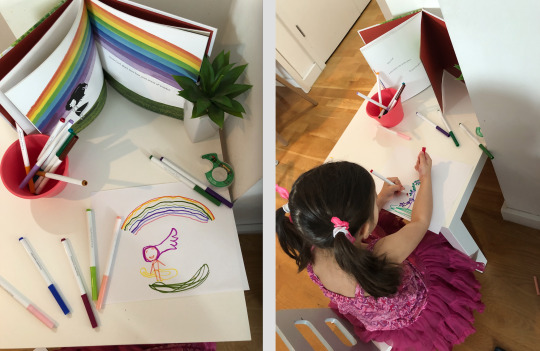
Step 3: Work to put the drawings in chronological order of events within the story. Then, tape the story together in that order.
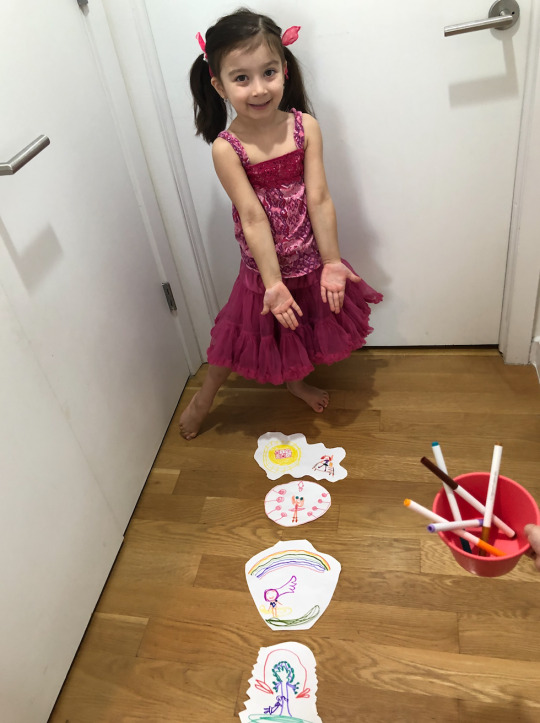
Step 4: Have your child wear the chain of drawings along the length of their back and retell the story back to them using their pictures as a visual.

Step 5: Thank you so much to Maria, Chloe, and Davis! We hope you enjoy your stories and artworks as much as we did.

FOR AGES 7+:
LET’S CREATE
Step 1: Think of a story that is important in your life. Do you have a favorite book? Or a story from your family? For our lesson, we’ll be using the Kwakwaka'wakw origin story.
Step 2: Make a list of all the characters in that story.

Step 3: Sketch out what these characters look like on paper. Then, color them in.

Step 4: Cut out your drawings so that each character is on its own piece of paper.

Step 5: Now, take a new piece of paper and roll it up. Tape the paper so that it stays rolled up. If you have popsicle sticks or cardboard, you can use this instead to create sticks for your puppets.
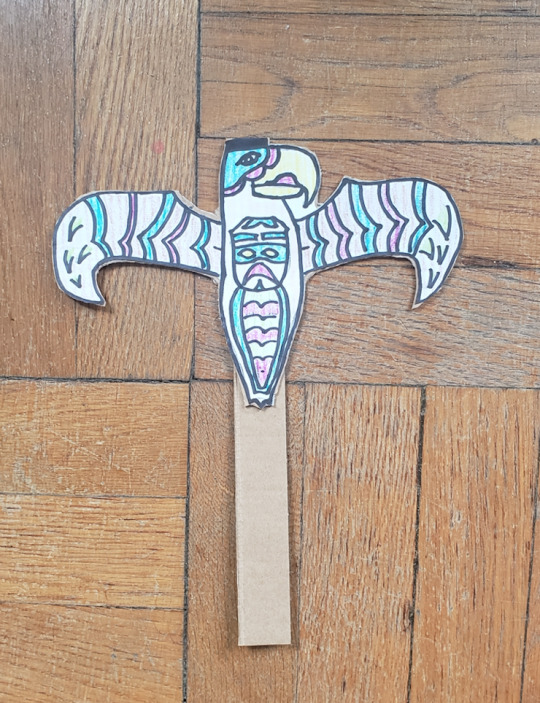
Step 6: Tape your paper or sticks to the back of your characters.

Step 7: Now you can have a puppet show and tell your story!
Posted by Tamar MacKay and Noé Gaytán
Photos from top: Kwakwaka'wakw. Baleen Whale Mask, 19th century. Cedar wood, hide, cotton cord, nails, pigment). Brooklyn Museum, Museum Expedition 1908, Museum Collection Fund, 08.491.8901. Creative Commons-BY (Photo: Brooklyn Museum); For ages 2–6 (Photos: Maria Leto, Brooklyn Museum); For ages 7+: (Photos: Noé Gaytán, Brooklyn Museum)
#miniartlessons#bkmeducation#museum from home#art education#art making#craft#bkmartsofamericas#native american#indigeneous art
50 notes
·
View notes
Photo
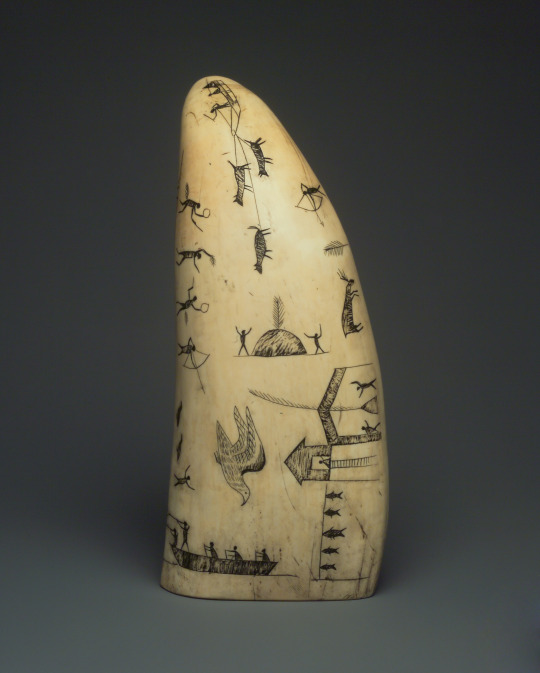
Our upcoming exhibition, Climate in Crisis: Environmental Change in the Indigenous Americas, looks at the effects of climate change on Indigenous communities across the western hemisphere. With works spanning 2,800 years, this installation explores the complex worldviews of Native communities, the threat of environmental destruction and its relationship to colonialism, and the work being done by Indigenous activists to protect the planet.
Posted by Joseph Shaikewitz
Eskimo artist. Engraved Whale Tooth, late 19th century. Sperm whale tooth, black ash or graphite, oil. Brooklyn Museum; Gift of Robert B. Woodward, 20.895. Creative Commons-BY.
#bkmartsofamericas#climate#climate crisis#indigenous americas#indigenous#americas#western hemisphere#native#worldviews#communities#climate change#environmental destruction#environment#colonialism#activists#art#planet#brooklyn museum
110 notes
·
View notes
Photo

Want to learn more about an artist in our collection? Download our Ask Brooklyn Museum app and chat with one of our experts! 💬
Kenojuak Ashevak (Inuit, 1927-2013). The Enchanted Owl, 1960. Stone cut on paper. Brooklyn Museum, Gift of George Klauber, 1998.122. © artist or artist's estate
#askbkm#bkmartsofamericas#brooklyn museum#app#technology#museums#Kenojuak Ashevak#inuit#art#artist#arts of the americas#owl#print#stune cut
73 notes
·
View notes
Photo
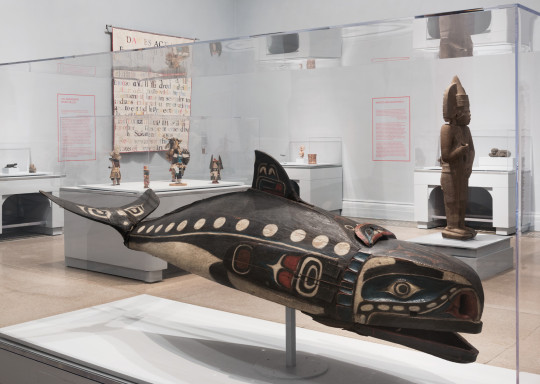
Now open, Climate in Crisis: Environmental Change in the Indigenous Americas draws upon the strength of our Arts of the Americas collection to highlight the complex worldviews of Indigenous peoples and explore how their beliefs, practices, and ways of living have been impacted by the ongoing threat of environmental destruction. With regional groupings spanning North, Central, and South America, this exhibition highlights different Indigenous understandings of the natural world and activism toward environmental justice.
Posted by Joseph Shaikewitz
Installation view by Jonathan Dorado
#bkmartsofamericas#climateincrisis#climate crisis#environmental change#indigenous#indigenous americas#arts of the americas#worldviews#belief#destruction#climate change#global warming#environmental justice#activism#natural world#planet
87 notes
·
View notes
Photo
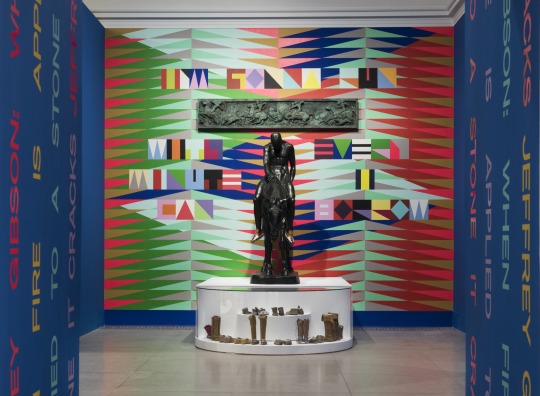
Jeffrey Gibson, an artist of Choctaw and Cherokee descent, incorporates elements of Native American art and craft into his practice, creating a rich visual and conceptual dialogue between his work and the histories that inform it. In our new exhibition Jeffrey Gibson: When Fire Is Applied to a Stone It Cracks, he selected objects from our collection, which are presented alongside his recent work. The resulting multimedia, floor-to-ceiling installation questions long-held institutional categorizations and representations of Indigenous peoples and Native American art. See it now through January 10, 2021.
Installation view by Jonathan Dorado
#jeffrey gibson#jeffreygibsonbkm#bkmartsofamericas#native american#native american art#choctaw#cherokee#art#artist#contemporary art#Indigenous peoples#installation#multimedia#art history#history#brooklyn museum#brooklyn
78 notes
·
View notes
Photo

This tetrapod (four-legged) vessel reflects how the ancient Maya visualized the world across three interconnected levels: the celestial overworld, the earthly middleworld, and the watery underworld of the dead. This expansive idea of the world and the place of humans within it has been displaced since European colonization in the 1500s, when land came to be divided into a series of geopolitical borders. The Maya vessel, now on view in the exhibition Climate in Crisis: Environmental Change in the Indigenous Americas, serves as a reminder of the ways that colonial worldviews contradict Indigenous understanding of the environment, and the effects of these tensions on national and international climate policies today.
Posted by Joseph Shaikewitz
Maya artist. Tetrapod Bowl with Lid, 350–450. Ceramic, pigment. Brooklyn Museum; Ella C. Woodward Memorial Fund, 64.217a–b. Creative Commons-BY.
#climateincrisis#bkmartsofamericas#brooklyn museum#maya#celestial#worlds#climate change#climate crisis#environment#indigenous#vessels#tetrapod#bowl#ceramic#arts of the americas
57 notes
·
View notes
Photo
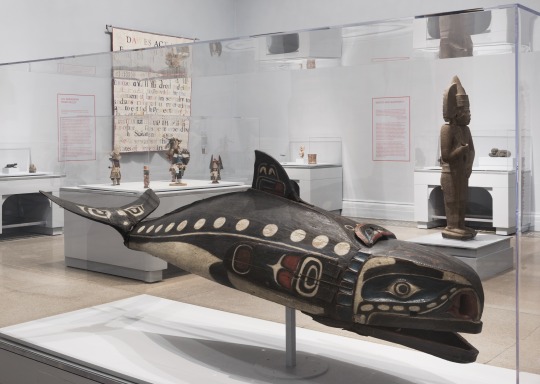
Tag along on a virtual tour of Climate in Crisis: Environmental Change in the Indigenous Americas led by Joseph Shaikewitz and Shea Spiller, Curatorial Assistants, Arts of the Americas and Europe!
Climate in Crisis: Environmental Change in the Indigenous Americas explores the severe impact that climate change is having on Indigenous communities across the hemisphere, and how this situation has an even longer history rooted in the legacies of the European colonialism. The exhibition highlights the complex worldviews of Indigenous peoples and considers how their beliefs, practices, and ways of living have been impacted by the ongoing threat of environmental destruction.
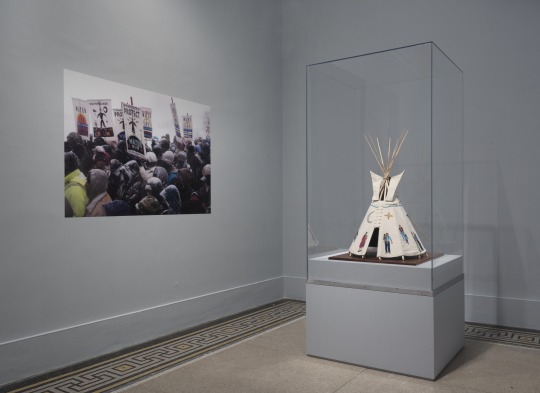
In the introductory gallery, a photograph by Tailyr Irvine from the Dakota Access Pipeline (DAPL) protests at Standing Rock connects to a model tipi by Teri Greeves. According to Greeves, “In staking down a tipi, a way of life is staked down and thus sacred space is created and held.”

This vessel encapsulates the Maya understanding of the world and its existence across three interrelated levels: the celestial overworld, the earthly middleworld, and the watery underworld. In the exhibition, the work serves as a reminder of how geopolitical borders and discussions of climate policy on a national level contradict Indigenous worldviews and the spread of myriad cultures across the hemisphere for millennia.
This intricate basket by Gail E. Tremblay combines traditional weaving methods with 16mm film taken from a 1967 ethnographic documentary on Inuit life. As Tremblay explains:
“With the threat of global warming, I want people to think about the importance of the Arctic, how it supports life, and how the Native people who live there keep that life going. The exploitation of oil and fossil fuels is causing people to destroy the Earth, and the lack of balance is endangering life on the planet.”

This grouping of work from the Canadian and U.S. Northwest Coast includes Preston Singletary’s Guardian of the Sea, which speaks to the scarcity of natural resources once abundant in the region. Singletary comments:
“Corporations and even our current government are rolling back environmental regulations, defunding scientific research, building oil pipelines which endanger our clean water, and a whole host of other issues that endanger our health as a nation. In my opinion, this is due to the lack of a true spiritual connection in relation to nature. . . . It is driven by a blind and misguided capitalist perspective that is not balanced by a respect for our environment.”
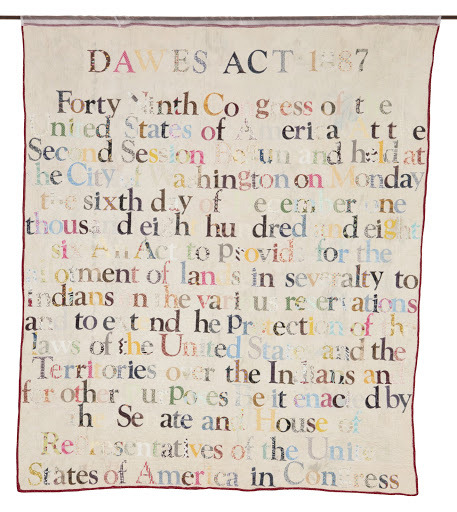
In her Broken Treaty Quilt series, the artist Gina Adams reproduces passages from United States government treaties with Native tribes on vintage quilts to draw attention to the deception and violence committed against Indigenous peoples during the formation of the U.S. The passage of the Dawes Act in 1887, which Adams quotes here, broke reservations up into individually owned plots that could be bought and sold, going against core Native understandings of communal ownership. As a result, more than ninety million acres of tribal land were sold to non-Native people.

The exhibition also highlights the perspectives of Indigenous climate activists, like Xiya Bastida, who notes:
“People say the climate movement started decades ago, but I see it as Indigenous people protecting Earth thousands of years ago. We need to bring [this philosophy] back and weave it into today’s society. . . . It shouldn’t be ‘we the people.’ It should be ‘we the planet.’”
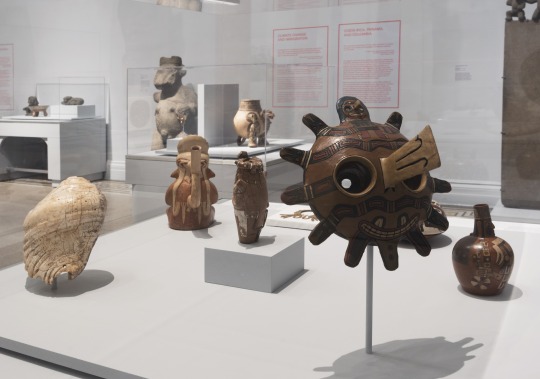
This case shows artwork from present-day Peru that relates to the concept of “pacha,” a Quechua word that encompasses interrelated ideas of space, place, time, and the universe. This expansive worldview continues to inform much Indigenous activism and advocacy for environmental stewardship.
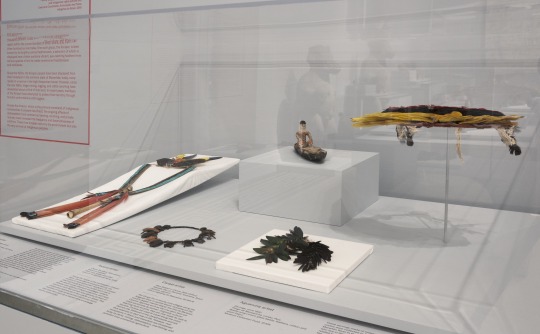
Several million Indigenous people inhabited the Amazon rainforest prior to European colonization in the 1500s, and their artistic traditions—such as the brightly colored featherwork and earrings made of beetle-wing covers—and connection to the natural world continue to this day. Climate in Crisis emphasizes the survivance of Indigenous communities in the Americas and beyond as well as the central place of Indigenous worldviews in the creation of environmental justice.
Thanks for joining us! Tune in next Sunday for another virtual tour of our galleries!
Installation views of Climate in Crisis: Environmental Change in the Indigenous Americas. Brooklyn Museum, February 14, 2020–January 10, 2021. (Photos: Jonathan Dorado)
#bkmartsofamericas#climateincrisis#virtualtour#arts of americas#climate crisis#global warming#indeginous art#brooklyn museum#virtual tours
33 notes
·
View notes
Photo
“’When fire is applied to a stone it cracks’ is credited as an Irish proverb with no identified author. This title describes my interest in providing a different perspective for viewers when looking at historical objects within an institutional setting. I often appropriate words from found texts, song lyrics, or poetry that have impacted me and have provided guidance as I try to create a space for myself, others, and the histories that are part of my heritage. This quote is both factual and metaphorically poetic. Heat can be applied to stone either naturally or deliberately until the stone will crack and break open. Fire is symbolic in many cultures and expressions of faith, and often represents divinity, passion, destruction, and transformation. On the other hand, stone is seen as dense, heavy, solid, and static. I read 'fire' in this quote to describe the innovative making, use of materials, transformative techniques, and the survivalist ethic of Indigenous people Our use of new and different materials to make things that support ourselves and our communities is the 'fire' that continues to break open the static and antiquated ideas regarding who we are and what we are capable of."
— Jeffrey Gibson
Jeffrey Gibson (Choctaw/Cherokee, born 1972). WHEN FIRE IS APPLIED TO A STONE IT CRACKS, 2019. Acrylic on canvas, glass beads and artificial sinew inset into custom wood frame. Courtesy of the artist and Kavi Gupta, Chicago. © Jeffrey Gibson. (Photo: John Lusis)
#jeffreygibsonbkm#jeffrey gibson#brooklyn museum#indigenous#bkmartsofamericas#historical#art#artist#words#text#lyrics#poetry#heritage#history#horrible histories#poetizando#heat#stone#fire#culture#faith#divinity#passion#document destruction#transformation
28 notes
·
View notes
Photo

Hey y’all! I’m Teresa Juarez Moran, and we’re back at it again with our first Virtual Teen Night: Whispers de la Tierra on Friday, May 15, from 5–7:30 pm.
Thousands of years ago, the people crafted artifacts emphasizing the importance of preserving the natural world and what it offered. Based on Jeffrey Gibson: When Fire is Applied to a Stone It Cracks and Climate in Crisis: Environmental Change in the Indigenous Americas, we aim to uplift immigrant and Indigenous rights, and highlight the perspective of Native communities whose lives have been threatened by environmental destruction. By allowing these injustices to be voiced, we encourage youth to join us in the stride for climate justice!
The night will showcase a panel discussion, Navigating the Layers of Climate Justice, starring activists Thanu Yakupitiyage, Xiye Bastida, and Helena Gualinga. Expect our very own Museum Apprentices dropping knowledge on the exhibitions with their famous Pop-Up Talks. Check out featured artist-makers to view their creations. Enjoy some poetry by Dena Igusti and Sonali Sharma. And, of course, it wouldn’t be Teen Night without the music: welcome musicians like STEFA*, Ernest Brockenberry, Xiuhtexcatl, Renata Flores, and our very own DJ InO!
That’s your invitation to join the party. Catch you there!
This program is free and open to all teens globally. Check out our full schedule here.
Whispers de la Tierra is organized by the Teen Night Planning Committee, our paid teen internship in public programming.
Posted by Teresa Juarez Moran
Music: Clean by Ernest Brockenberry
#bkmteens#teens#brooklyn museum#museums#virtual programming#virtual events#teen night#jeffreygibsonbkm#bkmartsofamericas#native american art#indigeneous art#climate change
9 notes
·
View notes
Video
CLOSING SOON—Frida Kahlo: Appearances Can Be Deceiving is in its final weeks at the Brooklyn Museum. This rare presentation exploring the artist's creative vision and self-crafted identity closes on May 12. Tap link in bio to get your tickets to experience Kahlo's clothing and personal items, paintings and drawings by the artist, and works of Mesoamerican art from our collection.
ULTIMOS DIAS—Frida Kahlo: Las apariencias engañan está en sus semanas finales en el Brooklyn Museum. Esta inusual muestra que explora la visión creativa e identidad auto-elaborada de la artista, cierra el 12 de mayo. De clic en el enlace en nuestra biografía para conseguir boletos y conocer de cerca la vestimenta, los artículos personales, las pinturas y los grabados de Kahlo, así como algunas obras Mesoamericanas de nuestra colección.
📽️ Nickolas Muray Home Movies: Frida Kahlo and Diego Rivera (about 1941). Digital file from 16mm acetate positive. From the collection of George Eastman Museum. © Nickolas Muray Photo Archives.
#fridakahlobkm#Frida Kahlo#brooklyn#nyc#brooklyn museum#identity#art#artist#art history#vision#clothing#personal items#paintings#photographs#artworks#drawings#mesoamerican#bkmartsofamericas
123 notes
·
View notes
Photo

Last month on Tumblr, we gave a behind-the-scenes look at the Brooklyn Museum’s Mesoamerican objects featured in Frida Kahlo: Appearances Can Be Deceiving. Now that the exhibition is open (with extended hours!) we can share some of their journey from lab to display. As we discussed before, conservators took photographs, inspected, and if necessary, treated or oversee the fabrication of custom mounts. (For more in depth details on our mount-making process read this post from last summer)
When it comes time for objects to be installed in their display cases, often conservators work with the museum's art handlers to make finishing touches and adjustments. On the left, you see our objects as they entered the conservation lab. Several, including two Colima figures, this Olemic figure, and this Nayarit Female Figure, are laying flat since they cannot stand upright on their own. On the right, they are mounted and installed in the gallery.
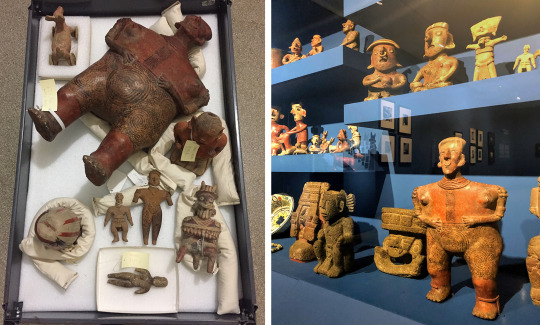
For objects that don’t have mounts, pieces of Mylar or Melinex, an archival grade polyester sheeting, were cut to match the footprint of each object. The Mylar acts as a barrier layer between the objects and the shelves. In the during-installation image on the left, you can see it under the greenstone necklace while an art handler determines the angle of the mask to its left.
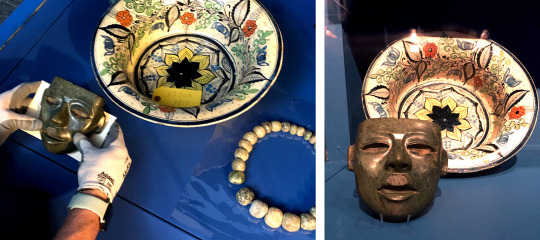
Ideally the mounts and mylar disappear once everything has been installed, although in some cases this isn’t possible because of the size or shape of an object.

While Kahlo’s paintings and costumes may take center stage in this exhibition, the New York Times described the important role the collection objects played. “In one gallery, the curators set out to re-create the vibe of Kahlo and Rivera’s home. Azure-painted walls and a case of Mesoamerican ceramic and stone sculptures and vessels, from the Brooklyn Museum’s permanent collection, evoke its spirit” said Rebecca Kleinman.

Installation view of Mesoamerican collection in Frida Kahlo: Appearances Can Be Deceiving. Photo: Vladimir Weinstein / BFA.com
The exhibition is only up through May 12, so be sure to come and walk through our Blue House gallery yourself.
Posted by Sasha Drosdick
#bkmconservation#fridakahlobkm#frida kahlo#mesoamerican#sculptures#vessels#ceramic#stone#bkmartsofamericas#mounting#installation#conservation#museums#art#art history#art museum
211 notes
·
View notes
Photo

If you ask someone to name five artists, they will likely name prominent male artists, but how many people can list five women artists? Throughout March’s Women’s History Month, we will be joining institutions around the world to answer this very question posed by the National Museum of Women in the Arts (NWMA). We will be featuring a woman artist every day this month, and highlighting artists in our current exhibition Half the Picture: A Feminist Look at the Collection which explores a wide range of art-making, focusing on enduring political subjects—encompassing gender, race, and class—that remain relevant today. The show is on view until March 31, 2019.
Together we hope to draw attention to the gender and race imbalance in the art world, inspire conversation and awareness, and hopefully add a few more women to everyone’s lists.
Shan Goshorn’s Color of Conflicting Values combines traditional Cherokee double-weave technique with nontraditional archival references. Here, Goshorn has woven together images of lush greenery, excerpts from the Indian Removal Act of 1830, and hand-painted depictions of the twenty-dollar bill—which celebrates President Andrew Jackson, for whom removal and dispossession of Native Americans was a legislative priority. Goshorn passed away in December of 2018, and we are honored to be featuring this important work in Half the Picture: A Feminist Look at the Collection.
Shan Goshorn (Eastern Band Cherokee, born Baltimore, Maryland, 1957) Color of Conflicting Values, 2013. Ink, acrylic, gold foil on Arches watercolor paper. Collection of Edward J. Guarino
#shan goshorn#5womenartists#halfthepicturebkm#native american#cherokee#weave#basketball#virtual money#andrew jackson#indian removal act#art#artist#art history#women artists#womens history month#brooklyn museum#bkmartsofamericas
99 notes
·
View notes
Photo


“In this evocative and complicated gallery I have placed PUSH (2018) at the far end near the Native American objects, which acts like an actual mirror into the past and also as a kind of atmospheric ‘cloud.’” — Rob Wynne
Installation views of Rob Wynne (American, born 1950). PUSH (2018) with [Probably] Yanktonai, Nakota, Sioux (Native American). Strap Dress with Red and Green Embroidery, early 19th century. Emulsion cured buckskin, dyed porcupine quills, glass beads, tin and copper tinklers, thread, sinew and pigment. Brooklyn Museum
#robwynne#rob wynne#native american#bkmartsofamericas#bkmamericanart#glass#activation#art#art history#native american art#arts of americas#mirror#atmospheric#contemporary art#artist#brooklyn museum
102 notes
·
View notes
Photo
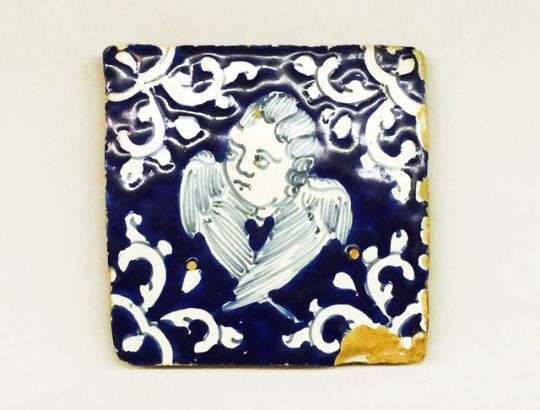
🔵 Here’s a little BLUESDAY inspiration from our Arts of the Americas collection, currently on view in Infinite Blue.
This blue-and-white glazed tile from Puebla, Mexico, features an angel motif, suggesting that it was made for a church or other religious structure. The use of blue-and-white comes from the influence of Chinese porcelain trade goods that moved through Mexico in the eighteenth century, when it was under Spanish rule. Coveted by Europeans as a sign of wealth, blue-and-white porcelain was imitated by Mexican artisans for local use in churches and wealthy homes.
Tile, circa 1700. Ceramic, glaze, 4 3/4 x 4 3/4 x 1/2in. (12.1 x 12.1 x 1.3cm). Brooklyn Museum, Museum Expedition 1942
#bkmartsofamericas#bluesday#infinitebluebkm#blue#puebla#mexico#angel#church#religious#chinese#porcelain#spanish#europeans#wealth#artisans#churches#wealthy#homes#highlight
21 notes
·
View notes
Photo
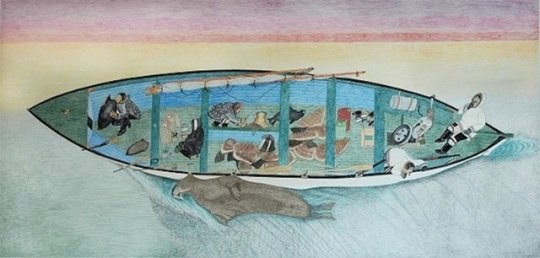
The Brooklyn Museum’s large colored-pencil drawing, Untitled (Successful Walrus Hunt), 2009 by Inuit artist Kanaginak Pootoogook is currently on display in the Venice Biennale in Italy. The work is on long-term loan as a promised gift from the Edward J. Guarino Collection. Biennale curator, Christine Macel, saw the drawing at the Brooklyn Museum in 2015 and was so enamored with it that she decided to include Pootoogook as one of the featured artists in the headlining exhibition Viva Arte Viva, the first Inuit artist in the Venice Biennale.
Posted by Nancy Rosoff
Kananginak Pootoogook (Canadian, Inuit, 1935-2010). Untitled (Successful Walrus Hunt), 2009. Colored pencil, ink, paper, framed. Arts of the Americas. Promised gift of Edward J. Guarino from the Edward J. Guarino Collection in honor of Edgar and Josep, L2014.2
#biennaledivenezia#kanaginak pootoogook#bkmartsofamericas#arsenale campo della tana#biennale di venezia#inuit#art#inuit art#printmaker#venice biennale#christine macel
61 notes
·
View notes